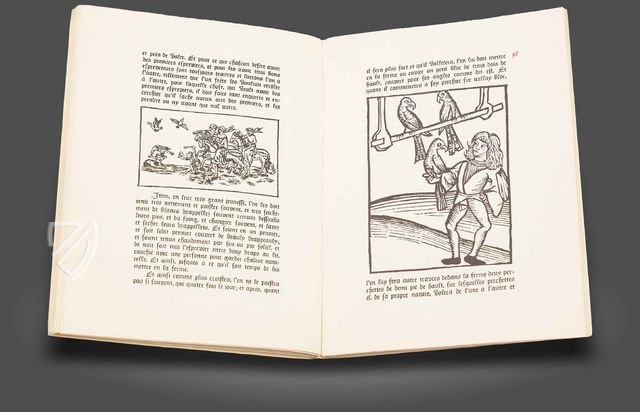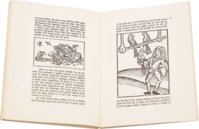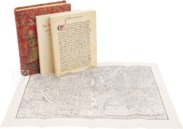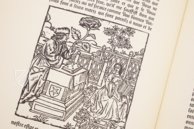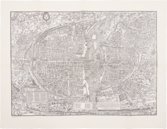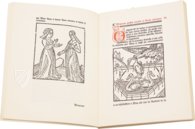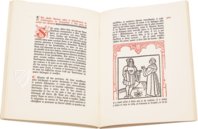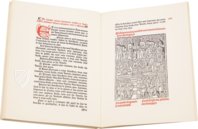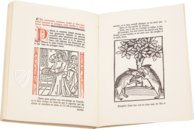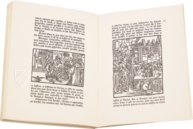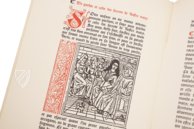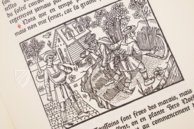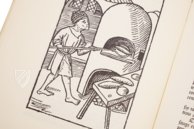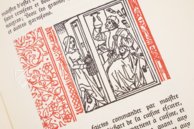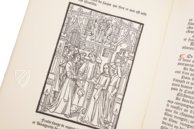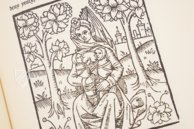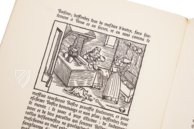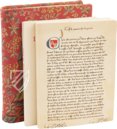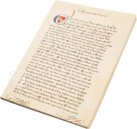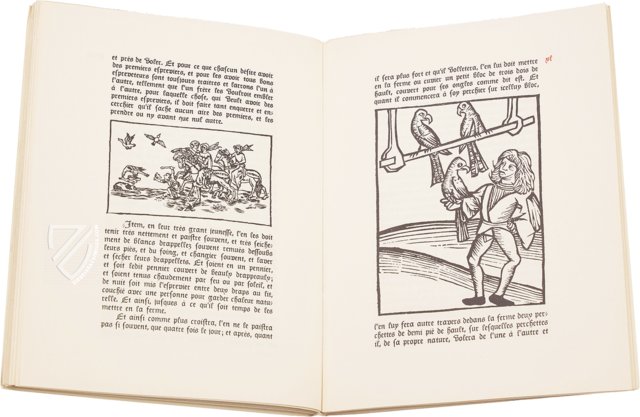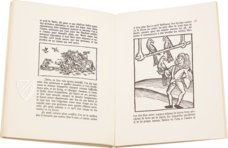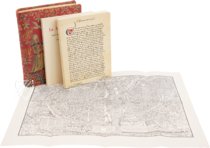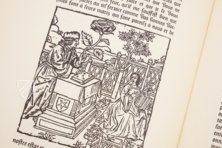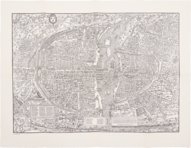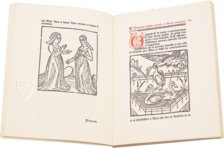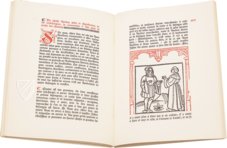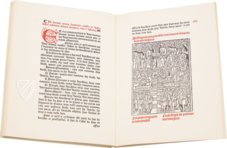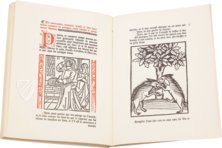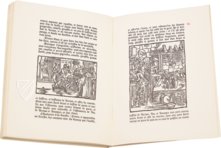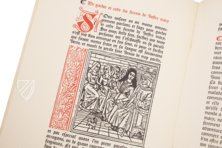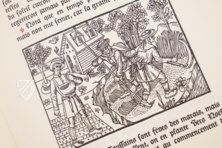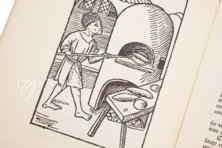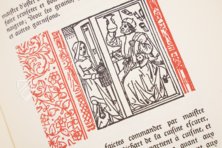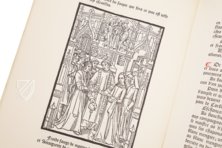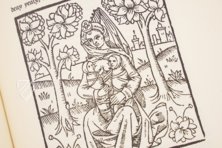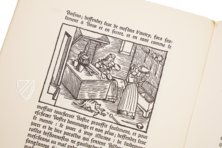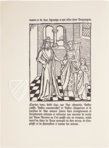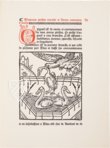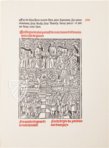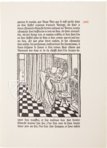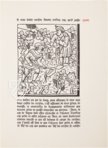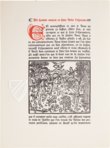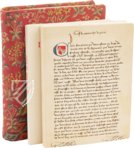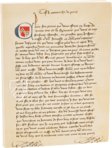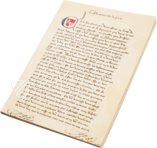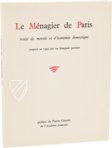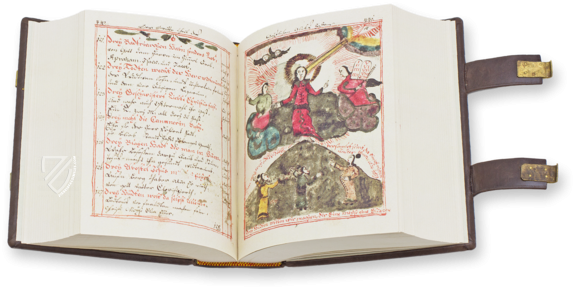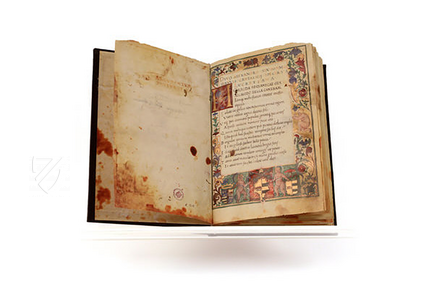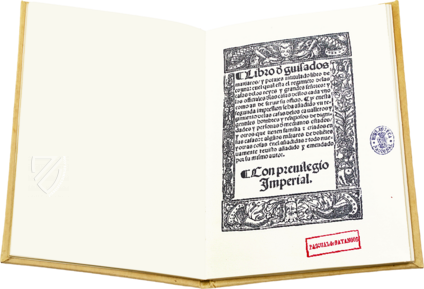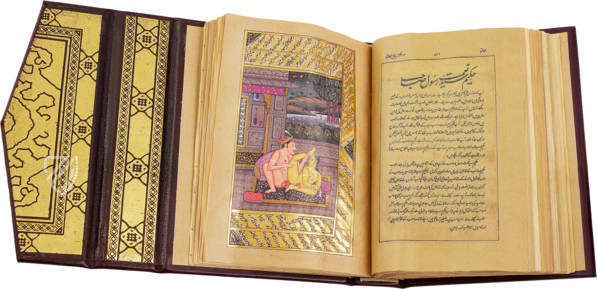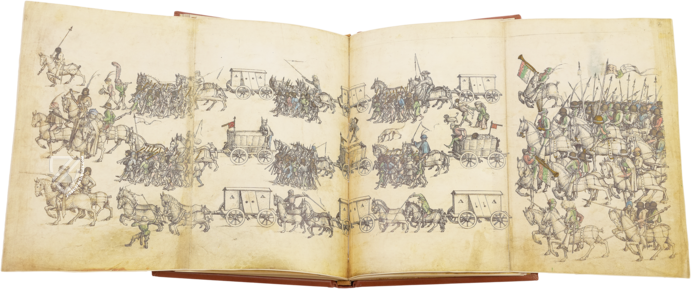The Parisian Household Book
(under 1,000€)
This famous French household guidebook, originally titled Le Ménagier de Paris or “The Housekeeper of Paris”, was written ca. 1392–94 and borrowed from similar works, some of which are cited by the author, who is presumed to be a member of the Parisian bourgeois. It is considered fundamental for the study of Parisian habits and customs in the 16th century and is written in the voice of an older husband giving counsel to his young wife – a 15-year-old orphan of good stock but lacking in manners. Although often incorrectly referred to simply as a cookbook, the central theme of the work is – unsurprisingly – wifely obedience. It also includes instructions on running a household, information on the consumption of the upper classes in Paris at the end of the 14th century, advice on gardening and selecting servants and horses, and extensive treatises ranging from cookery to hunting with sparrowhawks. This authoritative edition of the work from 1846 was printed with woodcuts from the 15th and 16th centuries and includes a map of Paris from ca. 1550.
The Parisian Household Book
This late-14th century work combines practical instructions for young brides concerning having a happy marriage and running a noble household with some historical facts, moralizing allegories and an exploration of the seven deadly sins and counter-virtues as well as containing the oldest treatise on cooking written in the French language. The text is addressed to a newly wed 15-year-old girl and narrated in the voice of her husband, an aging wealthy Parisian bourgeois. Aside from instructions on the morality, duties, and conduct expected of an upper-class woman, the work also includes practical texts on gardening, a cookbook with 380+ recipes, sample menus for hosting feasts, choosing and managing valets and maids, and the training and medical care of horses, dogs, and falcons. However, despite the benevolent tone of the work, its ultimate theme, aside from management, is that wives should show the same obedience to their husbands that they show to God.
Transmission of the Work
The work survives in three 15th century vellum manuscripts and a 16th century paper manuscript but was never printed, which speaks to the limited appeal of the work to just the upper crust of society. They are mostly un-illuminated works with signs of regular use that indicates they were used as practical guides rather than luxurious works of art for display. In 1843, the French bibliophile Baron Jérôme Pichon (1812–96) acquired a manuscript of the work and then acquired copies of two other extant manuscripts in order to compare them and published an authoritative version in 1846 under the title Le Menagier de Paris, Traite de Morale Et D'Economie Domestique. The codex takes the form of an early printed book utilizing a Gothic typeface and woodcuts from the 15th and 16th centuries printed in black and red ink. A map of Paris from ca. 1550 by Olivier Truschet and Germain Hoyauand Germain Hoyau, which is stored in the Basel University Library, is included as a compliment to the facsimile volume.
The Bourgeois Author
Although the work is generally believed to be literary in nature and the husband-narrator is himself an allegorical figure, but there are some clues about the identity of the anonymous author. There are some indications that he was connected in some way to the ducal court of Berry and the text reveals that he has a large house in Paris as well as a country estate. He has numerous servants, owns many animals and acres of farmland, and splits his leisure time between his urban pleasure gardens and hunting in his forests and fields. The husband-narrator embodies all patriarchal roles from father and husband to chaplain and advisor to feudal lord. His treatise is one of the most interesting prose texts to emerge from France during the Hundred Years’ War and yet makes no mention. Instead, the family home is presented as a refuge from the chaos and danger of the world and the people of Paris go about their business without fear of war, marauding brigands, or plague.
A Treatise in Three Parts
In the prologue, the author states that we work will be divided into three parts: a moralizing text on what makes a good wife, a cookbook and guide for managing a noble household, and finally a section on hosting guests including various games and other amusing activities. Section 1 consists of nine articles covering topics such as piety and prayers, modest dress, controlling one’s gaze, chastity, fidelity, obedience, caring for their husband’s reputation, keeping his secrets, and giving him good counsel. The second section concerning household management explains how virtue and hard work leads to one becoming wealthy as well as instructions for managing a garden, purchasing food, planning for events, hiring and managing servants, selecting and caring for horses and hunting dogs, and also has an extensive cookbook covering everything from simple everyday food to elaborate dishes for feasts. Clear parallels are made between the training and care of animals and the training and care of people be they servants, children, or one’s own wife. Only one part of the third section is complete – a treatise on raising and hunting with hawks – while the other two parts concerning dice, chess, parlor games, math-based games, and a book of riddles were never finished. The woman who took the teachings of this book to heart would be considered a most accomplished wife and hostess by medieval standards.
Codicology
- Alternative Titles
- Das Pariser Haushaltsbuch
Le Ménagier de Paris. Traité de morale et d'économie domestique. - Size / Format
- 120 pages / 27.0 × 21.5 cm
- Origin
- France
- Date
- 1846
- Epochs
- Style
- Language
- Illustrations
- Numerous woodcuts based on models of the 15th and 16th centuries
- Content
- Guidance for a woman's proper behavior in marriage and running a household
- Artist / School
- Jérôme Pichon (publisher)
The Parisian Household Book
Île de la Cité
The historic center of Paris is an island in the center of Paris that has served throughout history as a Gallic settlement, a Roman fortress, and became the site of the palace of Clovis I, the first king of the Franks, in 508. It increased in importance throughout the Middle Ages and is the site of the cathedral of Notre Dame, the royal chapel of Sainte-Chapelle, and Paris’ first hospital, the Hôtel-Dieu. After the kings of France moved their residence from the island in the Late Middle Ages, it became the judicial and legislative center of France hosting both its highest court and the Parliament of Paris.

The Parisian Household Book
A Bourgeois Parisian Family
The Parisian bourgeoisie were members of medieval guilds and an official class with both privileges, such as legal and jurisdictional protections, and duties, such as paying taxes, supporting charities, and arming themselves at their own expense for service in the city’s militia. There were official regulations concerning who was a member of the bourgeoisie, e.g. they first had to have a domicile in Paris for one year and one day.
This woodcut presents an idealized bourgeois Parisian family standing on a checkered tiled floor in front of a window with rounded arches and a mullion; a diamond-patterned lattice glass paned window can be seen on the right and an open portal on the left with the sun shining in. All of the family members wear elegant flowing garments, and the women are fashionably – and more importantly – modestly dressed. In keeping with the theme of the text, the father is benevolently but sternly lecturing his wife and daughter, who obediently accept his wise counsel.
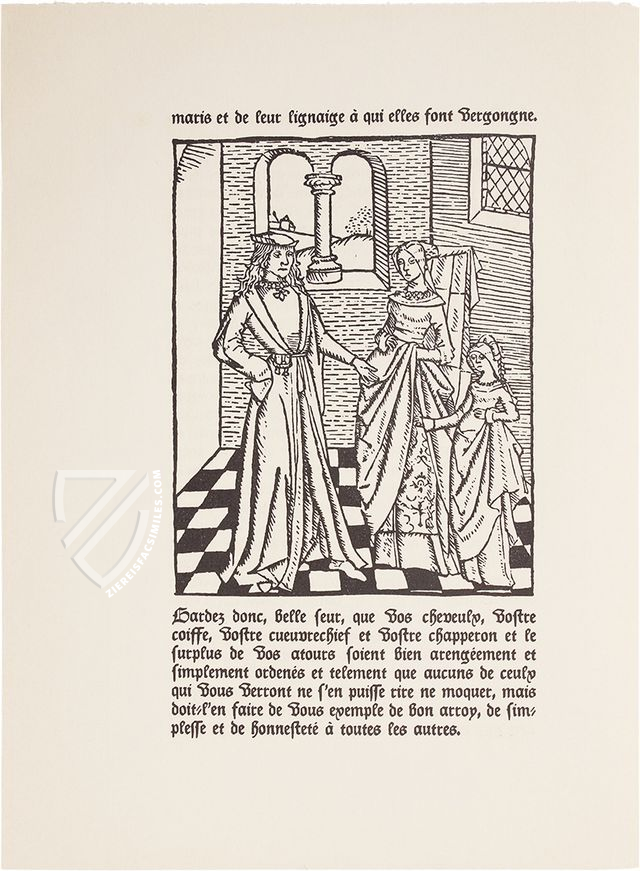
#1 Le Ménagier de Paris. Traité de morale et d'économie domestique.
Language: French
(under 1,000€)
- Treatises / Secular Books
- Apocalypses / Beatus
- Astronomy / Astrology
- Bestiaries
- Bibles / Gospels
- Chronicles / History / Law
- Geography / Maps
- Saints' Lives
- Islam / Oriental
- Judaism / Hebrew
- Single Leaf Collections
- Leonardo da Vinci
- Literature / Poetry
- Liturgical Manuscripts
- Medicine / Botany / Alchemy
- Music
- Mythology / Prophecies
- Psalters
- Other Religious Books
- Games / Hunting
- Private Devotion Books
- Other Genres
- Afghanistan
- Armenia
- Austria
- Belgium
- Belize
- Bosnia and Herzegovina
- China
- Colombia
- Costa Rica
- Croatia
- Cyprus
- Czech Republic
- Denmark
- Egypt
- El Salvador
- Ethiopia
- France
- Germany
- Greece
- Guatemala
- Honduras
- Hungary
- India
- Iran
- Iraq
- Israel
- Italy
- Japan
- Jordan
- Kazakhstan
- Kyrgyzstan
- Lebanon
- Liechtenstein
- Luxembourg
- Mexico
- Morocco
- Netherlands
- Palestine
- Panama
- Peru
- Poland
- Portugal
- Romania
- Russia
- Serbia
- Spain
- Sri Lanka
- Sweden
- Switzerland
- Syria
- Tajikistan
- Turkey
- Turkmenistan
- Ukraine
- United Kingdom
- United States
- Uzbekistan
- Vatican City
- A. Oosthoek, van Holkema & Warendorf
- Aboca Museum
- Ajuntament de Valencia
- Akademie Verlag
- Akademische Druck- u. Verlagsanstalt (ADEVA)
- Aldo Ausilio Editore - Bottega d’Erasmo
- Alecto Historical Editions
- Alkuin Verlag
- Almqvist & Wiksell
- Amilcare Pizzi
- Andreas & Andreas Verlagsbuchhandlung
- Archa 90
- Archiv Verlag
- Archivi Edizioni
- Arnold Verlag
- ARS
- Ars Magna
- ArtCodex
- AyN Ediciones
- Azimuth Editions
- Badenia Verlag
- Bärenreiter-Verlag
- Belser Verlag
- Belser Verlag / WK Wertkontor
- Benziger Verlag
- Bernardinum Wydawnictwo
- BiblioGemma
- Biblioteca Apostolica Vaticana (Vaticanstadt, Vaticanstadt)
- Bibliotheca Palatina Faksimile Verlag
- Bibliotheca Rara
- Boydell & Brewer
- Bramante Edizioni
- Bredius Genootschap
- Brepols Publishers
- British Library
- C. Weckesser
- Caixa Catalunya
- Canesi
- CAPSA, Ars Scriptoria
- Caratzas Brothers, Publishers
- Carus Verlag
- Casamassima Libri
- Centrum Cartographie Verlag GmbH
- Chavane Verlag
- Christian Brandstätter Verlag
- Circulo Cientifico
- Club Bibliófilo Versol
- Club du Livre
- CM Editores
- Collegium Graphicum
- Collezione Apocrifa Da Vinci
- Comissão Nacional para as Comemorações dos Descobrimentos Portugueses
- Coron Verlag
- Corvina
- CTHS
- D. S. Brewer
- Damon
- De Agostini/UTET
- De Nederlandsche Boekhandel
- De Schutter
- Deuschle & Stemmle
- Deutscher Verlag für Kunstwissenschaft
- DIAMM
- Droz
- E. Schreiber Graphische Kunstanstalten
- Ediciones Boreal
- Ediciones Grial
- Ediclube
- Edições Inapa
- Edilan
- Editalia
- Edition Deuschle
- Edition Georg Popp
- Edition Leipzig
- Edition Libri Illustri
- Editiones Reales Sitios S. L.
- Éditions de l'Oiseau Lyre
- Editions Medicina Rara
- Editorial Casariego
- Editorial Mintzoa
- Editrice Antenore
- Editrice Velar
- Edizioni Edison
- Egeria, S.L.
- Eikon Editores
- Electa
- Emery Walker Limited
- Enciclopèdia Catalana
- Eos-Verlag
- Ephesus Publishing
- Ernst Battenberg
- Eugrammia Press
- Extraordinary Editions
- Fackelverlag
- Facsimila Art & Edition
- Facsimile Editions Ltd.
- Facsimilia Art & Edition Ebert KG
- Faksimile Verlag
- Feuermann Verlag
- Folger Shakespeare Library
- Franco Cosimo Panini Editore
- Friedrich Wittig Verlag
- Fundación Hullera Vasco-Leonesa
- G. Braziller
- Gabriele Mazzotta Editore
- Gebr. Mann Verlag
- Gesellschaft für graphische Industrie
- Getty Research Institute
- Giovanni Domenico de Rossi
- Giunti Editore
- Graffiti
- Grafica European Center of Fine Arts
- Guido Pressler
- Guillermo Blazquez
- Gustav Kiepenheuer
- H. N. Abrams
- Harrassowitz
- Harvard University Press
- Helikon
- Hendrickson Publishers
- Henning Oppermann
- Herder Verlag
- Hes & De Graaf Publishers
- Hoepli
- Holbein-Verlag
- Houghton Library
- Hugo Schmidt Verlag
- Idion Verlag
- Il Bulino, edizioni d'arte
- ILte
- Imago
- Insel Verlag
- Insel-Verlag Anton Kippenberger
- Instituto de Estudios Altoaragoneses
- Instituto Nacional de Antropología e Historia
- Istituto dell'Enciclopedia Italiana - Treccani
- Istituto Ellenico di Studi Bizantini e Postbizantini
- Istituto Geografico De Agostini
- Istituto Poligrafico e Zecca dello Stato
- Italarte Art Establishments
- Jan Thorbecke Verlag
- Johnson Reprint Corporation
- Josef Stocker
- Josef Stocker-Schmid
- Jugoslavija
- Karl W. Hiersemann
- Kasper Straube
- Kaydeda Ediciones
- Kindler Verlag / Coron Verlag
- Kodansha International Ltd.
- Konrad Kölbl Verlag
- Kurt Wolff Verlag
- La Liberia dello Stato
- La Linea Editrice
- La Meta Editore
- Lambert Schneider
- Landeskreditbank Baden-Württemberg
- Leo S. Olschki
- Les Incunables
- Liber Artis
- Library of Congress
- Libreria Musicale Italiana
- Lichtdruck
- Lito Immagine Editore
- Lumen Artis
- Lund Humphries
- M. Moleiro Editor
- Maison des Sciences de l'homme et de la société de Poitiers
- Manuscriptum
- Martinus Nijhoff
- Maruzen-Yushodo Co. Ltd.
- MASA
- Massada Publishers
- McGraw-Hill
- Metropolitan Museum of Art
- Militos
- Millennium Liber
- Müller & Schindler
- Nahar - Stavit
- Nahar and Steimatzky
- National Library of Wales
- Neri Pozza
- Nova Charta
- Oceanum Verlag
- Odeon
- Orbis Mediaevalis
- Orbis Pictus
- Österreichische Staatsdruckerei
- Oxford University Press
- Pageant Books
- Parzellers Buchverlag
- Patrimonio Ediciones
- Pattloch Verlag
- PIAF
- Pieper Verlag
- Plon-Nourrit et cie
- Poligrafiche Bolis
- Presses Universitaires de Strasbourg
- Prestel Verlag
- Princeton University Press
- Prisma Verlag
- Priuli & Verlucca, editori
- Pro Sport Verlag
- Propyläen Verlag
- Pytheas Books
- Quaternio Verlag Luzern
- Reales Sitios
- Recht-Verlag
- Reichert Verlag
- Reichsdruckerei
- Reprint Verlag
- Riehn & Reusch
- Roberto Vattori Editore
- Rosenkilde and Bagger
- Roxburghe Club
- Salerno Editrice
- Saltellus Press
- Sandoz
- Sarajevo Svjetlost
- Schöck ArtPrint Kft.
- Schulsinger Brothers
- Scolar Press
- Scrinium
- Scripta Maneant
- Scriptorium
- Shazar
- Siloé, arte y bibliofilia
- SISMEL - Edizioni del Galluzzo
- Sociedad Mexicana de Antropología
- Société des Bibliophiles & Iconophiles de Belgique
- Soncin Publishing
- Sorli Ediciones
- Stainer and Bell
- Studer
- Styria Verlag
- Sumptibus Pragopress
- Szegedi Tudomànyegyetem
- Taberna Libraria
- Tarshish Books
- Taschen
- Tempus Libri
- Testimonio Compañía Editorial
- Thames and Hudson
- The Clear Vue Publishing Partnership Limited
- The Facsimile Codex
- The Folio Society
- The Marquess of Normanby
- The Richard III and Yorkist History Trust
- Tip.Le.Co
- TouchArt
- TREC Publishing House
- TRI Publishing Co.
- Trident Editore
- Tuliba Collection
- Typis Regiae Officinae Polygraphicae
- Union Verlag Berlin
- Universidad de Granada
- University of California Press
- University of Chicago Press
- Urs Graf
- Vallecchi
- Van Wijnen
- VCH, Acta Humaniora
- VDI Verlag
- VEB Deutscher Verlag für Musik
- Verlag Anton Pustet / Andreas Verlag
- Verlag Bibliophile Drucke Josef Stocker
- Verlag der Münchner Drucke
- Verlag für Regionalgeschichte
- Verlag Styria
- Vicent Garcia Editores
- W. Turnowski Ltd.
- W. Turnowsky
- Waanders Printers
- Wiener Mechitharisten-Congregation (Wien, Österreich)
- Wissenschaftliche Buchgesellschaft
- Wissenschaftliche Verlagsgesellschaft
- Wydawnictwo Dolnoslaskie
- Xuntanza Editorial
- Zakład Narodowy
- Zollikofer AG

